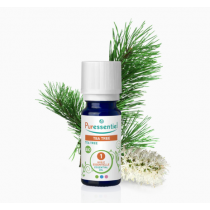Tea tree essential oil is extracted by distilling the leaves, which gives it a powerful, camphor-like smell. Native to Australia, the tea tree is a tall, bushy evergreen shrub that was discovered by naturalists accompanying Cook on a journey down the Endeavor River. They named it so because they used it as a tea substitute, considering it fragrant and invigorating.
Description
Family: Myrtaceae Origin: Australia Producing organ: leaves Type of odour: strong, camphoric, “medical”
Possible uses
Apply onto the skin: Yes +++ (pure state on a small area and diluted in vegetable oil for repeated applications on large areas or where the skin is sensitive). Swallow: Yes ++ Inhale: Yes ++
Main properties
Anti-septic, disinfectant, anti-bacterial, fungicide, anti-viral. And also Anti-mite, anti-tiredness, anti-infectious, anti-parasite, healing effect, venous decongestant, helps perspiration (”warmth”), supports the immune defences, radio-protective. Mental Action Stimulating, neurotonic.
Major indications
Skin infections: acne, abscesses, cutaneous and vaginal mycoses, cuts, scabs, mouth ulcers, gingivitis, herpes (labial or genital), bites (dog, tick, etc.), insect bites, lice, psoriasis, warts, shingles. Summer sores: insect bites, burns, sunburn
Other very good indications Urinary infections: cystitis Respiratory infections: tonsillitis, bronchitis, whooping cough and other coughs, flu, otitis, nasopharyngitis, sinusitis Chilliness, hemorrhoids
Usage tips
Skin disorders: Apply a few drops to damaged or infected skin, pure (if small area) or mixed with vegetable oil (if large skin area).
Acne (clay mask): In massage: 5 drops of Tea Tree HE + 5 drops of Palmarosa HE in 5 ml of Apricot Kernel HV, all in a creamy mixture of clay and water. 1 mask per week. As a hair mask against lice (see also “lavender”).
Lice – “shock” preparation! Apply 25 drops of tea tree mixed with 25 drops of lavender in 100 ml of sweet almond oil. Distribute half of the mixture on damp hair, just before shampooing, then comb through wet hair and squeeze the rest of the mixture onto the scalp. Comb again line by line, from the skull to the tip of the hair, starting from the forehead to go to the nape of the neck. Wrap the hair in plastic wrap and leave in place for 2 hours. Rinse, make 2 shampoos, rinse again very well. Pass a nit comb to be sure to eliminate everything. Repeat this treatment 7 days later to eliminate any “surviving” nits or lice.
Infections and disorders in general (all): Apply 2 to 4 pure drops next to the affected organ (throat, chest, around the ear, sinuses, next to the bladder, etc.), or 5 diluted drops in a tablespoon of vegetable oil for a larger skin area or massage along the spine (anti-fatigue) + In the bath: 10 drops of tea tree for 2 tablespoons of bath base or milk + Swallow 2 drops pure under the tongue or diluted in olive oil, honey, on a sugar or neutral tablet, 1, 2 or 3 times a day – as needed. + Breathe in a few drops on a disposable handkerchief, preferably to breathe in after cleaning the respiratory tract with seawater.
Other Use Tea tree is an excellent household disinfectant and deodorizer. The recipe: In an opaque glass bottle (preferably brown) fitted with a pourer, mix 1 teaspoon of tea tree, 1 teaspoon of cinnamon, 1 teaspoon of pine and 4 teaspoons of lemon. Shake before using with a few drops on a sponge or directly poured on the area concerned (siphon, toilet bowl, etc.). For a reinforced "deodorizing" effect, fill a small spray bottle with household alcohol (which you will find in liters in supermarkets, it also works well in white alcohol vinegar), add a few drops of your essential oil mixture and spray throughout the room.
Contraindication
You can apply it pure on the skin, provided that it is on a small surface and that you do not renew too often and for too long: 2 pure drops 2 to 3 times a day, for 3 days: this is the maximum! Like all essential oils, tea tree oil is prohibited during the first 3 months of pregnancy. It should also not be used during breastfeeding.




